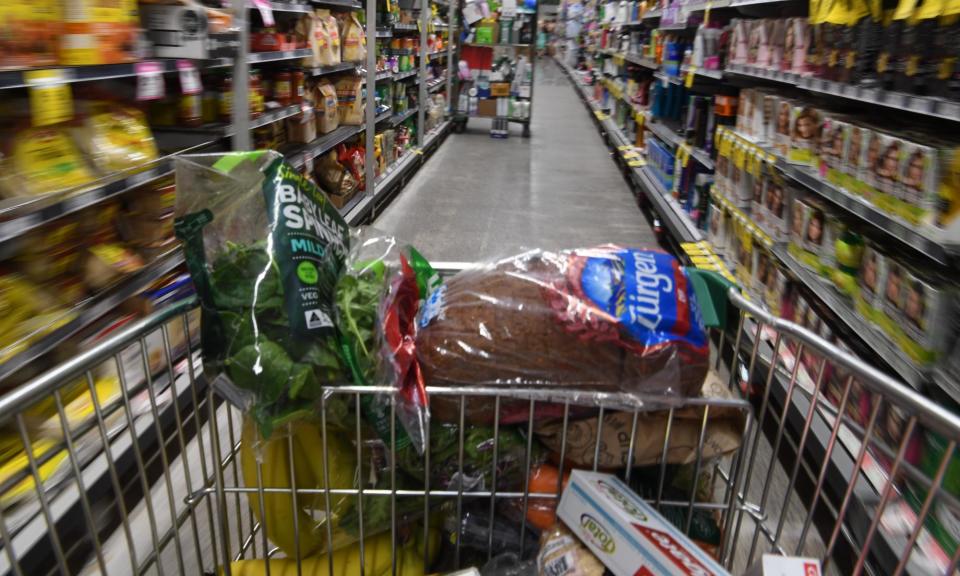Australia’s inflation rises to 4%, stoking concern interest rates could increase again

Australia’s monthly inflation rate increased to its highest level in 2024 in the latest indication that the Reserve Bank won’t be cutting interest rates soon and might yet hike again.
Consumer prices rose 4% last month from a year earlier, the Australian Bureau of Statistics said on Wednesday. That compared with the 3.6% pace recorded for April, and the 3.8% rate expected for May by economists.
The jump in May’s inflation was propelled in part by automotive fuel prices, which were up 9.3% from a year earlier even as they retreated 5.1% during the month itself.
Electricity prices were also up 6.5% from a year ago, quickening from April’s 4.2% pace. Without the federal and state rebates, power prices would have been 14.5% higher.
Food presented a mixed price picture. Overall prices were up 3.3% from May 2023, a slowdown from April’s 3.8% pace. Fruit and vegetable prices, though, climbed 4.4% compared with May 2023, continuing a recent rebound after prices posted a 1.2% drop in March.
Housing costs were 5.2% higher than in May 2023, with rents up 7.4%, reflecting the low vacancy rates in many cities.
Of particular concern will be the acceleration of the trimmed mean measure of inflation, which is what the RBA looks at more closely than the “headline” CPI figure. That jumped to 4.4% from 4.1% in April and 4% in March.
The monthly inflation figures are less complete than the quarterly ones, which won’t land until 31 July. The RBA expects the quarterly inflation pace will accelerate to 3.8% in the April-June period from 3.6% in the March quarter.
Related: When the cost of living bites, some things have to give – including the things you love
The monthly consumer price index peaked in December 2022 at 8.4%, a three-decade high, as post-Covid government stimulus combined with higher global energy prices in the wake of Russia’s invasion of Urkaine.
The RBA has said it won’t hesitate to raise its key interest rate – for a 14th time in this cycle – if it loses confidence that inflation can fall back within its 2%-3% target by the end of next year.
The federal budget, released earlier this month, forecast price increases could slow to 3% or less by the end of 2024. It is banking on energy rebates and other measures to “mechanically” lower the CPI even as the stage-three cuts inject more than $20bn into the economy this coming financial year.
The Australian dollar jumped about US0.2 cents to almost US66.7 in the wake of the inflation figures as investors shifted their bets about interest rates. Stocks also shed about 0.3 percentage points, before paring the losses to be down about 0.75% for the day.
The treasurer, Jim Chalmers, said inflation was “higher than we would like”, and much lower than 6.1% when Labor took office in May 2022.
“We’ve seen around the world that inflation can zig and zag on its way down, it doesn’t always moderate in a straight line and the last mile can be a bit harder,” Chalmers said.
His shadow counterpart Angus Taylor said the inflation outcome was “shocking but not surprising”.
“This is what happens when you have a big spending Labor government that’s completely out of touch with the economic reality,” Taylor said.
“We’ve now had four months in a row of accelerating core inflation. This will no doubt be of concern to the independent Reserve Bank.”
However, Steve Mickenbecker, an executive with Canstar, said the monthly inflation pop was “staggering”, confirming that inflation was not on the downward trajectory sought by the RBA.
The RBA will “surely lift rates” when its board meets in on 5-6 August because “the risk of baked-in inflationary expectations is too high”, Mickenbecker said.
“It’s worrying news for borrowers with an increase of 0.25 [percentage point] adding $100 to the monthly repayment on a $600,000 loan over 30 years,” he said. “Even without a rate increase, a three-month extension before a rate cut adds $288 in extra repayments to the same loan.”
David Bassanese, chief economist with Betashares, said the monthly CPI was a “shocker” that placed “huge pressure on the Reserve Bank to raise interest rates in August”.
“For the RBA, the concern remains that the longer inflation stays high, the greater the risk of it becoming embedded into inflation expectations and ongoing wage and price setting behaviour – particularly given the economy, despite weak growth, is still operating at a high level of capacity,” Bassanese said.
Prior to today’s figures all of the big four commercial banks – save ANZ – were forecasting the RBA would cut its cash rate in November. ANZ earlier this month broke ranks to predict the first rate cut wouldn’t happen until February 2025.

 Yahoo Finance
Yahoo Finance 